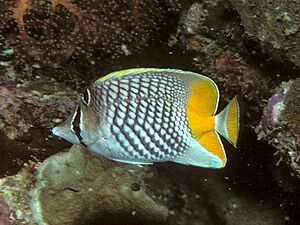Pearlscale butterflyfish facts for kids
Quick facts for kids Pearlscale butterflyfish |
|
|---|---|
 |
|
| Conservation status | |
| Scientific classification | |
| Genus: |
Chaetodon
|
| Species: |
xanthurus
|
The pearlscale butterflyfish (Chaetodon xanthurus) is a beautiful marine fish. It is also known as the yellow-tailed butterflyfish, crosshatch butterflyfish, or Philippines chevron butterflyfish. This fish is a type of ray-finned fish and belongs to the butterflyfish family, called Chaetodontidae.
Contents
What Does It Look Like?
The pearlscale butterflyfish can grow up to about 15 centimetres (5.9 in) long. Both male and female fish look very similar. Their bodies are a shiny, pearly white. Each scale has a black edge, which makes the fish look like it has a cool cross-hatch pattern on its sides.
The back part of the fish is orangey-yellow, and the base of its tail fin is white. Its head is a bit darker than its body. It has a special pattern on its head, including black stripes over its eyes and a black spot with a white edge on top of its head.
Where Does It Live?
You can find the pearlscale butterflyfish living on or near reefs in the central Indo-Pacific region. They live in places like Indonesia and the Philippines. You can also find them further north, up to the Ryukyu Islands in Japan.
Life in the Wild and in Aquariums
Pearlscale butterflyfish are active during the day. They usually live in waters deeper than 6 metres (20 ft). You can find them in clear waters near coastal reefs or on outer reef slopes. They often hang out around Acropora staghorn corals.
These fish are generally peaceful. In the wild, they can be seen alone, in pairs, or in small groups. However, they can be a bit bossy towards other fish that look similar to them.
Keeping Them in an Aquarium
Because of their bright colors, pearlscale butterflyfish are popular aquarium fish. If you want to keep one, you should have an aquarium that is at least 50 gallons. The water temperature should be between 74 and 80 degrees F.
Even though they can be a bit aggressive sometimes, they are also delicate. They need peaceful tankmates to stay healthy and happy. They might get along with other butterflyfish that have different color patterns, but it's not always guaranteed to be peaceful. If you add more than one to a tank, it's best to add them at the same time. Having lots of "live rock" with places for them to hide helps them feel safe and less stressed.
What Do They Eat?
In their natural home, pearlscale butterflyfish eat algae, soft coral polyps, and small creatures that live on the seabed, called benthic invertebrates. Because they eat coral, they can cause problems for living corals in an aquarium.
If you have them in a tank, you should feed them a variety of foods. This can include mysid shrimp, brine shrimp, krill, and foods that contain spirulina or other algae.
Fish Family Tree
The pearlscale butterflyfish is part of a group of "crowned" butterflyfishes. These fish share a similar look: dark, forward-pointing patterns on silvery bodies, a black-and-white spot on their head, and yellow to red back parts. Other fish in this group include the Atoll Butterflyfish (C. mertensii), Eritrean Butterflyfish (C. paucifasciatus), and Seychelles butterflyfish (C. madagaskariensis).


